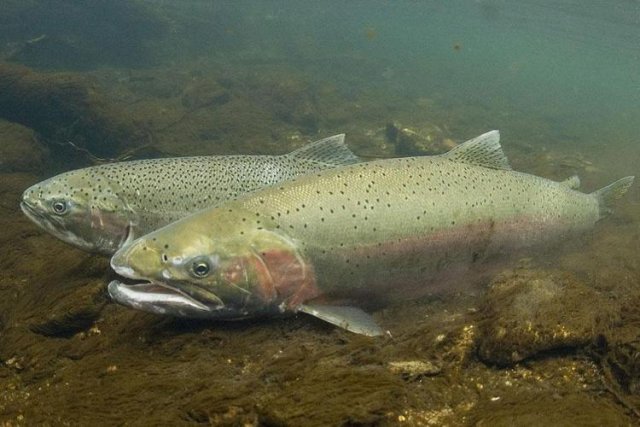Seasonally Warm Habitats May Help Cold Water Fish Adapt to Climate Change

Published November 1, 2021
Warming trends in the Pacific Northwest have the region’s conservation experts worried about the survival of critical salmon and trout species. As climate change ramps up water temperatures, states and tribes are turning to ecologists for help identifying ways to protect these species, several of which are endangered or threatened, from further population declines. While fish and wildlife managers typically prioritize habitat that is cool in the warmer months for conservation plans, a new study warns that focusing only on cold-water habitat may not be enough.
The Klamath River once supported the third largest salmon fishery on the West Coast, but decades of human pressure and a changing climate have caused many species in this river to decline. The river snakes from its headwaters near Upper Klamath Lake, Oregon, through the Cascade mountain range, winding 257 miles before spilling into the Pacific Ocean in California. Commercial and recreational fisheries and five Native American tribes depend on the salmon and trout species that traverse this aquatic highway at key times of the year, returning to their birthplace for spawning after reaching adulthood in the ocean.
As cold-blooded animals, fish are sensitive to the temperatures in their environments. Fish that are adapted to cold water, like salmon and trout, are especially vulnerable to temperatures above a certain threshold. Under climate change, fish kills from higher-than-average summer temperatures are becoming more common in the region—even as far north as Canada.
“This warming in summer reduces the survival of adults and embryos, affects spawning, and makes fish more susceptible to disease,” said EPA fish biologist Joe Ebersole, who co-authored the study. “Combine warming with other stressors like extreme droughts and fires, toxins, and nonnative fish, pretty soon they can’t handle all the stressors.”
The threat from extreme summer temperatures has led conservationists to prioritize areas that stay cool in the summer—so-called “climate refugia” because they act as refuges for fish during heat waves. But the researchers wanted to know whether focusing on summer temperatures overlooks areas of the river fish use at other times of the year.
To understand how fish take advantage of different areas of the river at different times of year, the researchers paired water temperature models and simulations of fish foraging behavior. They found that areas of the river that are too warm in summer are cool enough for fish to feed during most other months of the year. In fact, their findings suggest that fish grow more when they can access both cold and seasonally warm areas of the river. The study is published in the March 2021 issue of Nature Climate Change.
Ebersole said fish are experts at finding opportunities to grow and reproduce, despite environmental pressures. In the Klamath River system, summer heat and algal blooms create nearly toxic conditions in Upper Klamath Lake and downstream reservoirs. During the warmest months, fish migrate away from bad water quality to cold-water refuges, surviving and breeding with energy stored up from winter foraging. In the fall, winter, and spring, fish return to the seasonally warm areas to feed and build back their fat reserves.
“They are able to move around to find the goldilocks zone at any given time of year,” says Ebersole. “For them, it’s a full-service resort with a nice pool, buffet, and air conditioner—they just have to swim from one area to another.”
A better understanding of the importance of seasonally warm habitats can help states and tribes decide where to prioritize climate adaptation efforts. Decisions about water resource use, land development, and habitat restoration can all influence water quality and, ultimately, how well these fish will adapt to climate change.
In addition, maintaining the connections between upstream and downstream habitats is critical to protecting these species. In parts of the Klamath River, aging dams have blocked salmon runs for decades and limited their movement through the river system. A state and tribal-led effort to remove the dams, expected to finish by 2023, aims to restore historical fish pathways and relieve some of the climate-related pressures facing this river system.
“There is more work to be done to find areas where there may be untapped potential for fish, if we give them the opportunity,” said Ebersole. “As we have seen in the past year, times are changing, and we may need new ways of thinking in the future.”
